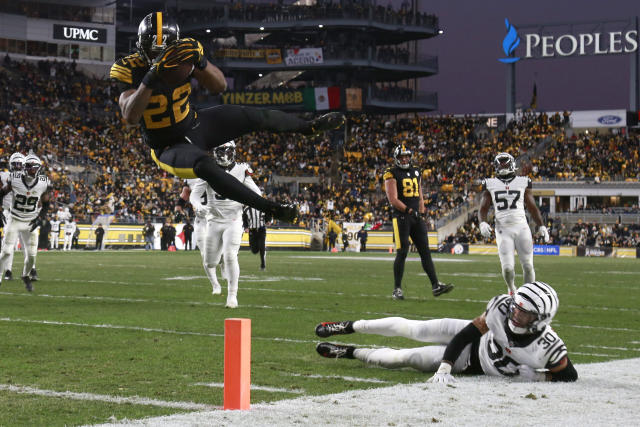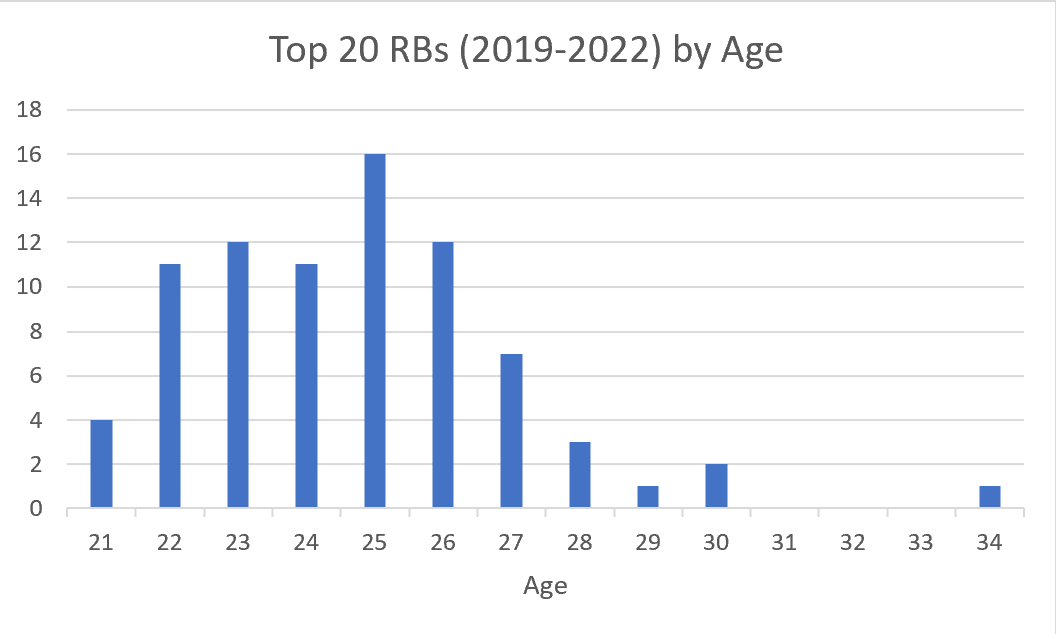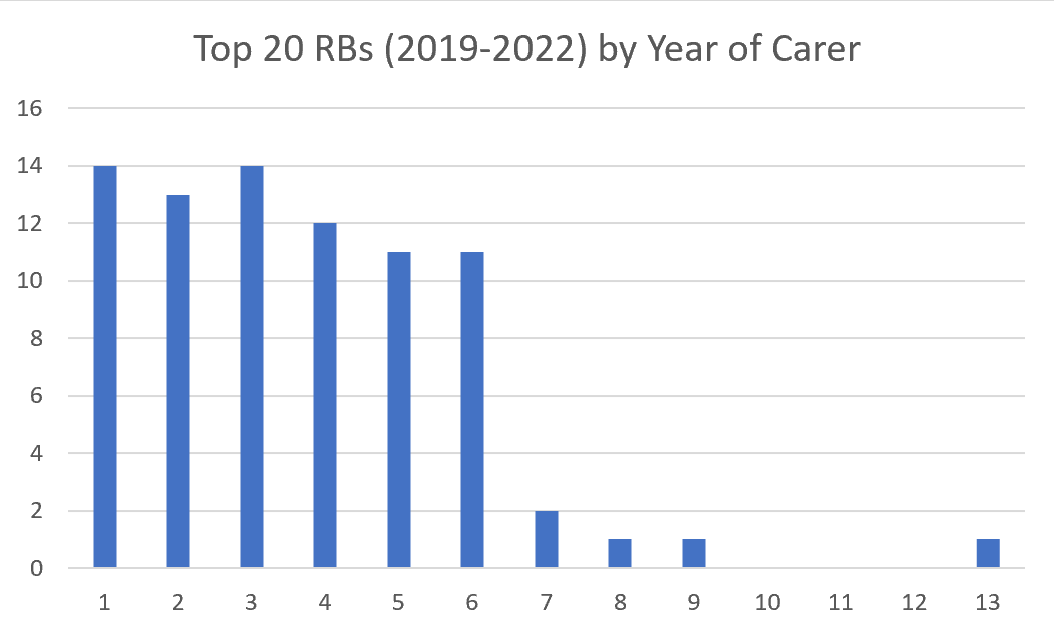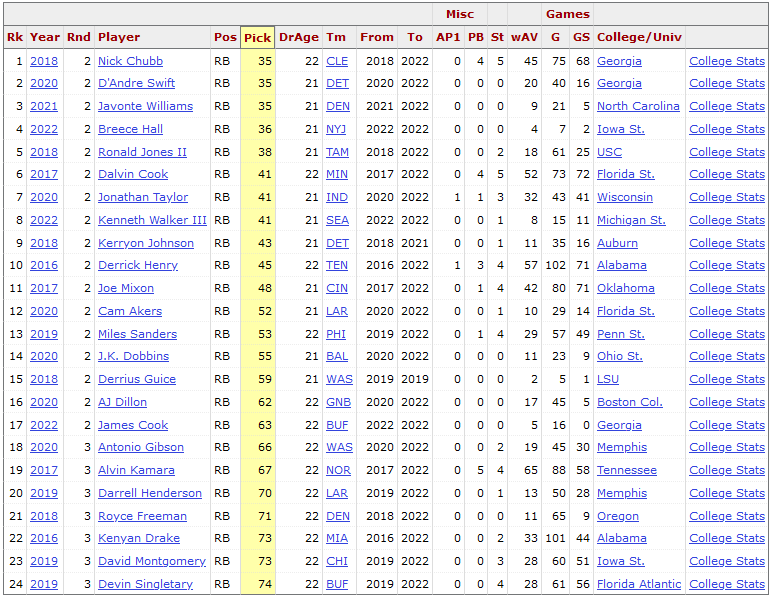There has been a lot of buzz in the NFL news lately about running backs not getting offered big second contracts by teams. Recently, Saquon Barkley, Tony Pollard, and Josh Jacobs all failed to come to terms with their respective teams before the Franchise Tag deadline (though Barkley signed an amended Tag agreement). Of course, Steelers fans know all about disgruntled running backs refusing to play on the franchise tag because they could not agree on a long-term deal. Reportedly, a number of running backs had a Zoom call this week to discuss the current state of the running back market. Najee Harris participated in the call and has become more outspoken about the inability of big-name running backs to secure large second contracts.
The Current Market
The current state of the running back market is unbalanced because of two massive deals at the top. Christian McCaffrey’s 4-year, $64 million deal has the highest average value at $16 million per season. He signed that deal with the Panthers in 2020 and was traded last year to the 49ers. While McCaffrey has the highest average value, New Orleans’ Alvin Kamara’s deal is for 5 years and $75 million. Kamara’s deal was also signed in 2020. There is a significant dropoff between those top-of-the-market deals and the next tier of Derrick Henry and Nick Chubb (both around $12.5 million per year) and Aaron Jones (at $11.5 million per year). The three aforementioned running backs on the franchise tag will make $10 million this year. No other backs are currently higher than $7 million per year.
The running backs at the top of the market have certainly earned their value with on-field performance, but the one thing they all lack is a Super Bowl Ring, or even an appearance in the Big Game. Much has been made on Twitter and elsewhere about the leading rushers on Super Bowl Champions and leading rushers in the game itself. In the last decade, no Super Bowl Champion has paid their leading rusher more than $2.5 million in the season they hoisted the Lombardi.
The State of Running Backs
Over the last four seasons, there have been a total of 575 running back seasons in which a player received at least one carry. Of those, only 45 (8%) ran for over 1000 yards. Over three times that many (158 total or 27%) ran for at least 500 yards. It has been said of athletes that “the best ability is availability” but that too has been a struggle for running backs on the whole. Only 155 (27%) appeared in at least 16 games in a season and just 25 (4%) started at least 16 games in a season. No backs over the age of 28 started at least 16 games in a season over the last four years (of the 70 possible).
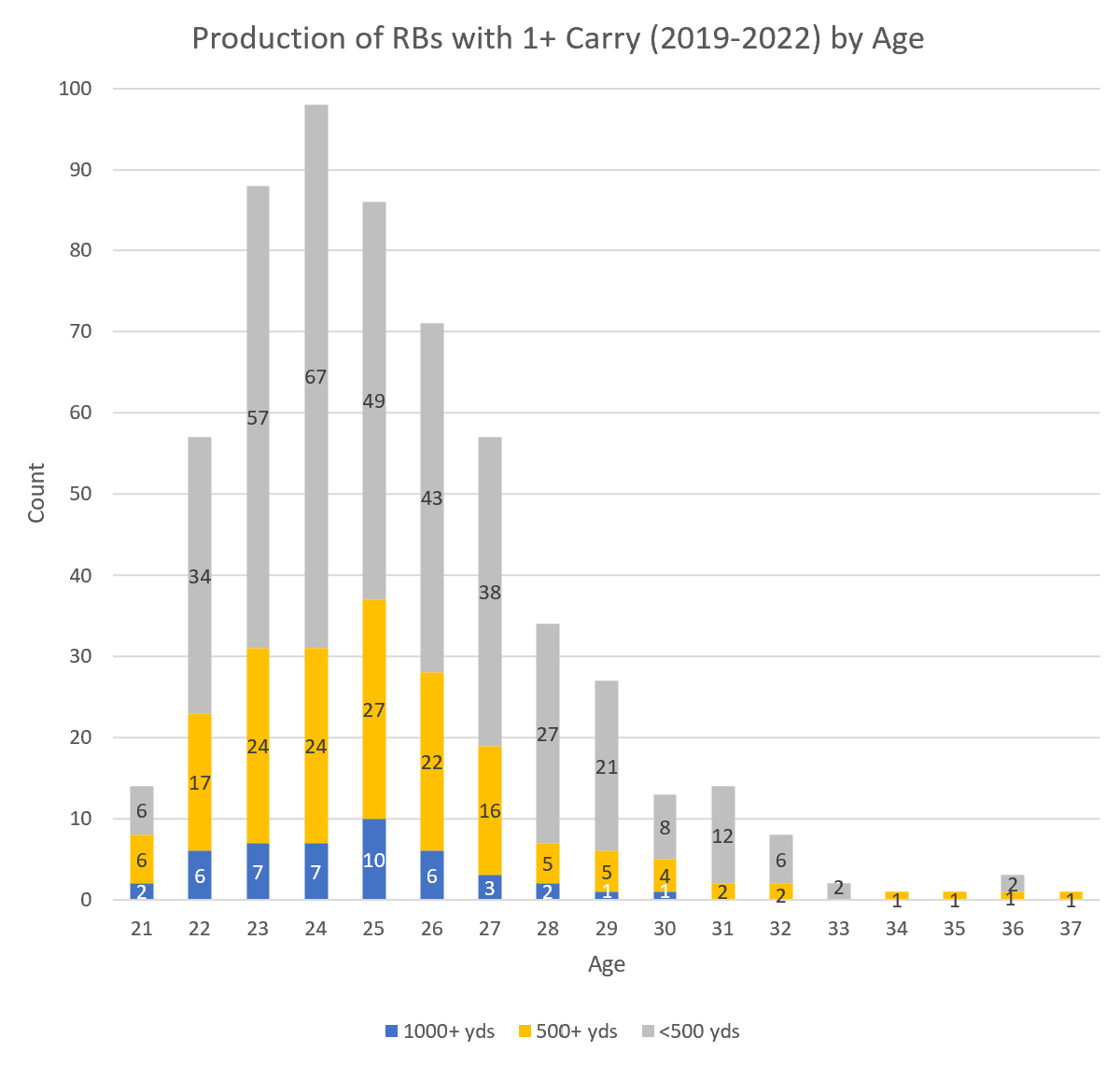 The tail end of this chart should probably be labelled “The Frank Gore and Adrian Peterson Zone” as they are responsible for all the 500+ yard season after Age 34. Those two aside the data shows a clear peak for running backs around Age 25, a slight dropoff in the Age 27 season, and a significant decline at 28 and older. The 28 and older group accounted for 104 of the 575 running back seasons with at least one carry over the last four years. Within that bracket only 4 (Mark Ingram, Carlos Hyde, Derrick Henry, and Aaron Jones) ran for over 1000 yards. For comparisons sake, 136 of the 471 seasons by backs aged 27 and younger produced 1000-yard rushers. This means that 8.7% of backs 27 and younger ran for over 1000 yards while less than half that (3.8%) of backs 28 and older accomplished the feat. Only 3 of the 104 RBs over the last four years started at least 16 games, and all of them were 28-year olds (Melvin Gordon, Derrick Henry and Aaron Jones). Not only is there a dropoff in production after a running back’s age 27 season, there is also a dropoff in availability as the wear and tear of the NFL grind and injuries accumulate.
The tail end of this chart should probably be labelled “The Frank Gore and Adrian Peterson Zone” as they are responsible for all the 500+ yard season after Age 34. Those two aside the data shows a clear peak for running backs around Age 25, a slight dropoff in the Age 27 season, and a significant decline at 28 and older. The 28 and older group accounted for 104 of the 575 running back seasons with at least one carry over the last four years. Within that bracket only 4 (Mark Ingram, Carlos Hyde, Derrick Henry, and Aaron Jones) ran for over 1000 yards. For comparisons sake, 136 of the 471 seasons by backs aged 27 and younger produced 1000-yard rushers. This means that 8.7% of backs 27 and younger ran for over 1000 yards while less than half that (3.8%) of backs 28 and older accomplished the feat. Only 3 of the 104 RBs over the last four years started at least 16 games, and all of them were 28-year olds (Melvin Gordon, Derrick Henry and Aaron Jones). Not only is there a dropoff in production after a running back’s age 27 season, there is also a dropoff in availability as the wear and tear of the NFL grind and injuries accumulate.
How Age Correlates to Running Back Success
Running back in the NFL is a young man’s game. Rookies have been able to come in and find quick successes and teams with specific running schemes (like San Francisco and Cleveland) have been able to find players off the scrap heap that exactly fit their mold. For purposes of this analysis, we looked back over the Top 20 rushers in the league over the last four years. We removed QBs from the list so some of the players listed actually finished 21st or 22nd in the league in rushing yards. From 2019 to 2022, of the 80 backs that finished in the Top 20, only 14 were age 27 or older and only 7 were aged 28 or older. Graphically looking at the data, there is a clear drop-off after a running back’s Age 26 season and even more after their Age 27 season.
Now, obviously players come out of college at different ages. So not only is there the drop-off after Age 27, but there is also a significant decline after the 6th year of a player’s career. Looking at the 80 seasons of players who finished in the Top 20 in rushing over the last 4 years, only 5 of them were past the 6th year of their career. Over the first six years, the number of players finishing in the Top 20 in rushing was relatively consistent.
Given this data on the age and career years of the Top 20 RBs over the last 4 seasons, it is no surprise that 59% of them were on rookie contracts. Just over a quarter (26%) were on second contracts or extensions with their original teams. Only 11% were signed off the free agent market. There was also one season each from players on 5th year options, tags, and tenders. Of the players on 2nd contracts to finish in the Top 20 in rushing, only two were older than 27 (Derrick Henry and Aaron Jones) and none were older than 28. There is some data here to support signing running backs through their Age 27 season, but there is certainly a decline in Age 28 and beyond.
Where Top Backs Come From
In total there were 48 different players that finished in the Top 20 over the last four seasons. Of those 48 players, more than half (25) were drafted in the first two rounds. Nine more were selected in the third round while only nine were selected in Day 3 of the Draft. Five more were undrafted free agents. Even though there is a dropoff in production with age, the elite backs are still being found in the early rounds of the draft.
Of those 80 seasons by the Top 20 backs over the last four years, 24 came from first-round picks. Nearly half, an astounding 35, came from backs drafted between 35th and 75th. If there is a “sweet spot” for drafting running backs, this appears to be it. Looking back at some of the players selected in that range over the years, it’s easy to see how many “hits” and how few “misses” have come in this 40-pick range.
To Pay or Not To Pay?
So should teams pay big second contracts to running backs? The data is not there to support long-term deals much beyond a back’s Age 27 season. One note of particular relevance with the situations of Saquon Barkley and Josh Jacobs along with the Steelers future considerations for Najee Harris – first round backs are eligible for the fifth-year option on their rookie deals. This can change the equation significantly as it pushes free agency off by another year. Add to that the potential to be franchise tagged for a 6th year, and even a back that enters the league at 21 years old will still be 27 and entering their 7th year in the league when they are able to test the free agent market. And as we’ve seen, those are close to the magic numbers for when production drops off.
So the big question remains – are second contracts for running backs worth it? Generally speaking, for most running backs the answer is probably no. However, that “no” comes with some caveats. If teams are cognizant of the player’s age, usage to date, and contract length then there certainly are deals to be made. Like the Steelers just did with Alex Highsmith, the Browns signed RB Nick Chubb to a 3-year extension prior to the final year of his rookie deal. Effectively, that made the extension a 4-year contract (final year of rookie deal + 3 additional years) but it gave Chubb more money sooner and kept the Browns out of the Franchise Tag situation. We may see more backs pushing to sign extensions like this prior to the end of their rookie deals as it gets them money in their pockets sooner. Chubb signed the extension before his Age 26 season, which is the same age as Saquon Barkley and Tony Pollard are now. Josh Jacobs, on the other hand, entered the league as a 21-year old and is only going into his Age 25 season. For Jacobs, an extension with the Raiders or testing the free agent market could yield bigger dividends since more of his productive window is still open.
The Najee Harris’ Situation
For Najee Harris, the situation is even worse. As good as Najee has been in his first two years with the Steelers (rushing for 1000 yards both seasons), there are additional factors in play. First, Najee played all four years at Alabama rather than entering the draft early. When the Steelers selected him in the 2021 Draft, it was about two months after his 23rd birthday. While most players (as shown in the listing above) enter the league in their Age 21 or Age 22 seasons, Najee was a 23-year old rookie. Entering this, his third season, Najee is already 25. His four-year rookie contract covers his Age 26 season. A potential fifth-year option would be his Age 27 season. If the Steelers and Najee are unable to come to a contract agreement and the Franchise Tag is used on him, that could potentially be Naj’s Age 28 season. As we’ve seen above, there is a significant decline in running back performance after this point. Unfortunately for Najee, he will likely not hit the free agent market until he is either at or near the end of the running back “window” of productivity.
On top of all that, Najee has been very heavily used in his career. Not just Mike Tomlin’s “run the wheels off him” philosophy of lead backs, but going back to Alabama where Najee had 718 touches (638 carries + 80 receptions) in his 4-year career. Add to that the 708 touches he has had in just two years in the NFL (591 carries + 117 receptions). Najee Harris is entering his Age 25 season with two years remaining on his rookie contract (plus potentially a fifth-year option and a franchise tag) and over 1,400 touches. Based on historical data, this does not set up well for Najee to see a big-money second contract given his age and usage.
People like to compare Najee Harris to Derrick Henry. But the contractual situations are very different. Henry came out of Alabama after his junior year with 619 touches. After spending the first two years as a backup, Henry finished his four-year rookie contract with 989 total touches (playoffs included). Since Henry entered the draft a year early, his rookie deal ended after his Age 25 season. In 2020 he was given the franchise tag (being a second-round pick ineligible for the fifth-year option) then signed a long-term deal (4 years, $50 million) which covered through his Age 29 season (which will be 2023). When Henry signed his second contract, he had just 200 more touches (college + pro combined) than Najee does currently with two years left on his rookie deal. Contractually, because of age, draft round, and usage, Najee Harris and Derrick Henry’s situations are very different. The better comparison for Najee Harris may be Nick Chubb who was also a 23-year old rookie and (as mentioned earlier) signed a 3-year extension prior to the final year of his rookie contract. If the Steelers went that route with Najee to avoid the fifth year option and franchise tag, that would mean negotiating and signing a new deal after the end of this season.

